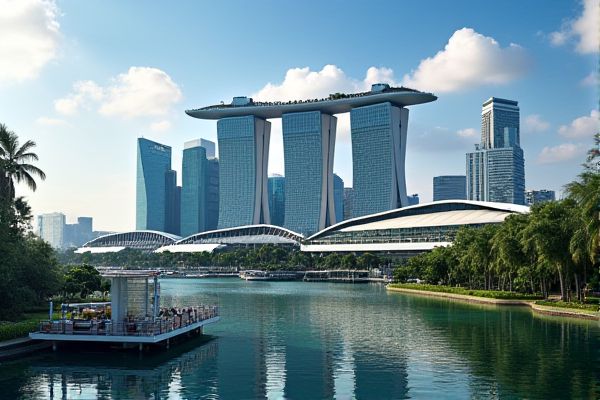
Weather and climate in Singapore: Tropical rainforest climate. Hot and humid year-round. Average temperature: 25-31degC. Two monsoon seasons. Heavy rainfall, especially November-January. Quick, frequent thunderstorms. Minimal temperature variability. High humidity levels consistently. UV index always high. No distinct seasons.
Tropical rainforest climate.
Singapore boasts a Tropical Rainforest Climate, defined by consistently high temperatures and humidity, alongside significant rainfall distributed throughout the year. The region experiences two distinct monsoon seasons, the Northeast and Southwest, punctuated by inter-monsoon periods. Notably, the average annual rainfall is approximately 2340mm. For more detailed insights, explore the comprehensive [climate overview](https://www.minmaxtravel.com/travel-guide/singapore/singapore-overview/climate/) offered by Minmax Travel. This unique climate contributes significantly to Singapore's lush greenery and vibrant ecosystem.
Hot and humid year-round.
Singapore's climate is tropical, remaining hot and humid throughout the year, with temperatures averaging around 31°C during the day and rarely dipping below 23°C at night. The humidity levels in Singapore typically range between 70% and 90%, making it a consistently warm destination. For more detailed insights into Singapore's climate and its seasonal variations, the Singapore Overview section on Minmax Travel provides comprehensive information to help plan your visit.
Average temperature: 25-31°C.
Singapore's climate is characterized by average temperatures ranging from 25°C at night to 31°C during the day, with little seasonal variation due to its tropical location near the equator. The temperatures remain relatively consistent throughout the year, with averages of 32°C during the day and 25°C at night from December to January, and around 33°C during the day and 26°C at night for the rest of the year. For more detailed information about the weather patterns, you can visit the TravelOnline Singapore Weather page, which provides comprehensive insights and updates.
Two monsoon seasons.
Singapore experiences two distinct monsoon seasons: the Northeast Monsoon from December to early March, characterized by northerly to northeasterly winds and higher rainfall, especially from November to January; and the Southwest Monsoon from June to September, marked by southeasterly to southerly winds and occasional Sumatra squalls and afternoon thunderstorms. For more information on these weather patterns, you can visit the Weather of Singapore website.
Heavy rainfall, especially November-January.
In Singapore, the period from November to January experiences the highest rainfall, particularly during the wet phase of the Northeast Monsoon season. This period is characterized by heavy rainfall, frequent thunderstorms, and high humidity, with November to January being the wettest months due to the positioning of the Intertropical Convergence Zone near the region.
Quick, frequent thunderstorms.
Singapore experiences quick and frequent thunderstorms throughout the year, with these storms being sudden, heavy, and short-lived, occurring at any time of the day. The thunderstorms are particularly common during the inter-monsoonal periods and are often triggered by strong surface heating and sea breeze circulation. For more detailed information, visit the Singapore Weather page for insights and updates on the climatic patterns throughout the year.
Minimal temperature variability.
Singapore's climate is characterized by minimal temperature variability, with daily minimum temperatures usually not falling below 23-25°C and daily maximum temperatures not rising above 31-33°C, reflecting its tropical and humid climate with relatively small temperature variations throughout the year compared to mid-latitude regions. For further insights into the region's climatic patterns, you can explore this comprehensive Climate Science Report, which provides detailed analyses and data. This consistency in temperature affirms the island's stable weather conditions that are characteristic of equatorial climates.
High humidity levels consistently.
Singapore experiences high humidity levels, typically ranging from 70% to 90%, due to its tropical climate, proximity to the Equator, and surrounding water bodies. The highest humidity occurs during the rainy season, which spans from November to January. To understand more about managing these conditions, visit the detailed guide on How to Reduce Humidity in Singapore. Notably, the combination of weather patterns and geographical factors contributes to the persistent humidity Singaporeans encounter throughout the year.
UV index always high.
The UV Index in Singapore is relatively high, ranging between 6 to 9, due to its proximity to the equator, which results in intense sunlight throughout the year, necessitating constant sun protection to prevent skin and eye damage. For more information on how to protect yourself from these harmful effects, visit the UV Index Singapore website.
No distinct seasons.
Singapore has a Tropical Rainforest Climate with no distinct seasons, characterized by uniformly high temperatures and nearly constant precipitation throughout the year, influenced by the Northeast and Southwest monsoons. For more detailed information, you can explore the Minmax Travel Guide, which provides an extensive overview of Singapore's climate and weather patterns. This climate ensures that the city remains lush and green, offering a vibrant environment for locals and visitors alike.
